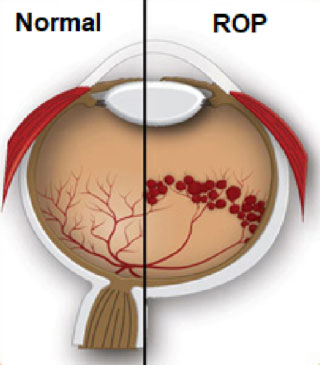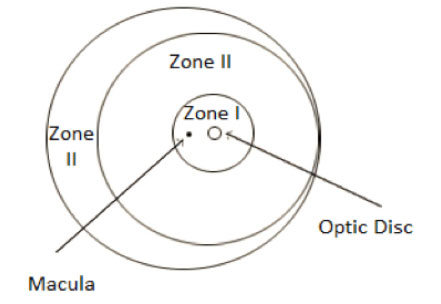Retinopathy of Prematurity
What is Retinopathy of Prematurity (ROP)?
Retinopathy of prematurity (ROP) is a potentially blinding disease observed in premature infants, caused by abnormal development of retinal blood vessels that generally begins during the first few days of life and may progress rapidly to blindness over a period of weeks. The retina is a layer on the inside of the back of the eyeball. When a baby is born prematurely, normal retinal vessel growth may be disrupted and abnormal vessels can develop, which can cause leaking and bleeding in the eye. In most cases, these vessels eventually grow correctly and ROP resolves without causing any damage. When ROP is severe, it can lead to a blinding scar tissue or detachment of the retina. Retinopathy of prematurity occurs in over 16% of all premature births. In babies weighing less than 1,500 grams at birth, over 50% will develop ROP.

What determines the severity of ROP?
Birth weight (≤1500g) and gestational age (≤30 weeks) are the most important risk factors for development of ROP. Besides these significant impact other factors that are associated with the development of ROP include respiratory distress, anemia and blood transfusion, poor weight gain, and the overall health of the infant.
How is ROP diagnosed?
Pediatric ophthalmologists or retina specialist skilled in the evaluation of infant eyes make the diagnosis of ROP. Dilating eye drops, which enlarge the pupil are routinely given prior to examination. The examination is done with an indirect ophthalmoscope which allows a wide-angle view of the retina. First a drop of topical anesthetic is applied to the eye to reduce the baby's discomfort. Then the baby's eyelids are held open with a device called a speculum and a special probe holds the eyeball still while the doctor examines it. Premature babies under 32 weeks or that weigh less than 1500 grams should be screened for ROP.
How ROP is classified?
Retinopathy of prematurity is classified by its location in the eye (the zone), by the severity of the disease (the stage) and by the appearance of the retinal vessels (plus disease). Zone 1 is the center of the retina while zone 3 is the far peripheral retina as seen in the diagram.
Zone I: Area centered on the optic disc and extending from the disc to twice the distance between the disc and the macula.
Zone II: A ring, concentric to Zone I, which extends to the edge of the retina on the side of the eye toward the nose.
Zone III: The remaining crescent area of the retina toward the side and away from the nose.
 There is an international classification system for staging of disease: Stage 0 is the mildest form of ROP; while Stage 5 is the most severe indicating total retinal detachment.
There is an international classification system for staging of disease: Stage 0 is the mildest form of ROP; while Stage 5 is the most severe indicating total retinal detachment.
Stage 1: Indicates that the outer edges of the retina are not receiving a normal blood supply. A demarcation line is visible where normal and abnormal blood vessels meet.
Stage 2: Indicates that the demarcation line has progressed to a ridge that develops as the abnormal vessel growth continues.
Stage 3: Indicates that the ridge has grown and the vessels have spread into the vitreous. There may be scarring and fluid leakage.
Stage 4: Indicates progression to partial detachment of the retina.
Stage 5: Is complete detachment of the retina.
Plus Disease: As ROP progresses the blood vessels may engorge and become tortuous. Plus disease is strongly associated with the development of severe ROP requiring treatment.
Aggressive Posterior ROP (APROP): It is a severe form of ROP which is characterized by fast progression to advanced stages. The disease may bypass the early stages 1-3 and progress to stage 5 quickly.
Which Babies With ROP Require Treatment?
Early stages of ROP may not require any treatment. When ROP reaches a certain level of severity, called type 1, the potential for retinal detachment and possibility of permanent visual loss becomes great enough to warrant consideration of treatment.
What does treatment involve?
If ROP advances, there are typically two treatment options. Laser photocoagulation which is applied to the immature portion of the retina is an established and effective technique for the treatment of ROP. The second approach involves a intraocular injection of anti-VEGF (Vascular Endothelial Growth Factor). This therapy is a relatively new treatment approach. Although the results are encouraging, further research is being done to help determine long term side effects and rate of ROP recurrence. In Stage 4-5 disease, vitreoretinal surgery is required to re-attach the retina.
Why are eye exams recommended after discharge from the hospital?
Retinopathy of prematurity may not be resolved before discharge from the hospital. It is extremely important to have timely eye exams after discharge. At the same time, even with successful treatment of ROP, there is a risk for the development of amblyopia, strabismus, and need for glasses.
Last Updated: October 23, 2024



























